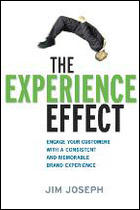This is pervasive across the pages of Jim Joseph’s new bookThe Experience Effect. No matter where we are in the scheme of our marketing plan, this question is imperative to keep us grounded in where we’re going. In this straightforward read, he details each building block (yes, there is an order to the madness of marketing), one at a time, to bring your marketing plan to a triumphant crescendo.
Rookies and seasoned marketing professionals alike will find Joseph’s book to be a simple and engaging read. He explains concepts with agility and flair, often incorporating brand examples we know well, but adding a new twist.
He explores concepts such as:
- How is Tide like Madonna?
- How does Louis Vuitton exemplify their expertise within retail with each of their locations?
- What are some innovative ways we can morph into the mindset of our target audience?
The processes Joseph outlines to create a successful brand (often visually with help from nifty charts, which is always nice) will add new luster to a stuck campaign, and provide new angles of thinking to arrive at new solutions.
He delivers quite well on his intention, which is to blend marketing concepts with real examples. He brings to life tools and ideas to evolve your brand’s “experience effect,” all of which can be seamlessly added onto any marketing plan. So what is the essence of this book? It’s not necessary to reinvent the wheel; rather, refresh and revitalize the tools at hand. Here are a few tools and pieces of advice he gives:
- “I may need running gear, but I want Nike”. Branding is about a rational need versus an emotional want. Yes there needs to be a rational component to your communication, but Joseph argues this is often the reason a consumer will initially come to the category. The emotional piece is what leads them to connect with your brand and welcome it into their lifestyle.
- There is a time and place for each touchpoint. Each piece of your marketing plan plays a different role in the life of your consumer. Know the touchpoint, know what it’s good at, and message appropriately. Be consistent, but avoid being cookie-cutter. TV is a mode of entertainment, a website is typically used to gather more information or to connect consumers, and a printed brochure should hit highlights of product benefits.
- “Music to my ears.” Build a brand soundtrack. Personify and bring your brand to life as much as you can. Using real-life examples of celebrities, songs, and music artists to articulate what the brand stands for will help guide you later on in the game when making choices about appropriate audiences to connect with.
Joseph brings his years of knowledge as a marketing professional to distill down the most important elements needed to build a successful brand. It’s not always easy, but it’s often simple. As he says in his book “the brilliance is in knowing what the obvious is.”
You can visit him at JimJosephExp.com to join the conversation.


